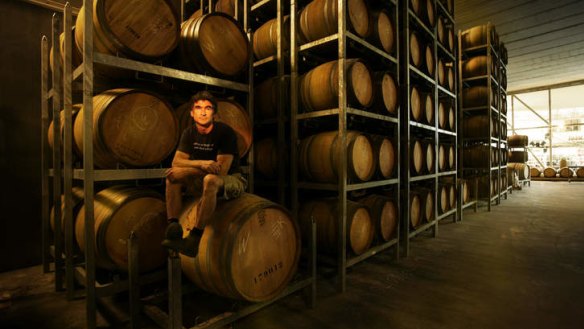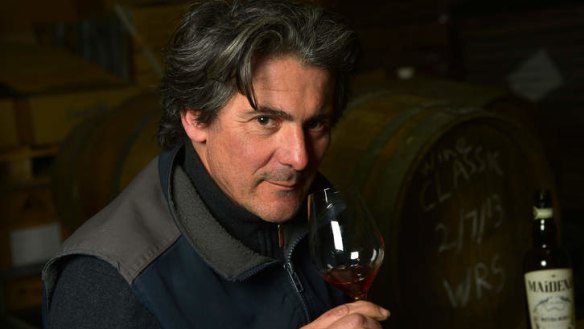Winemakers create Australian vermouths
Foraged botanicals sit nicely on the palate according to trail-blazing distillers.

Gilles Lapalus is being cagey, which is completely out of character.
The French-born winemaker, usually a picture of Gallic bonhomie, is running through the number of ingredients in his Maidenii vermouth.
There are plenty of numbers - 34 botanicals, 12 indigenous plants, one-third of which are fresh and foraged locally around Castlemaine - but the specifics are just a little blurred.
He's willing to reveal some of the indigenous plants, but not all.
A sly smile comes to his lips. "I have to keep some things a secret."
He claims to be the first maker of vermouth using Australian botanicals. No use giving away too much to the competition. And, surprisingly, there are competitors. Other winemakers are getting into side projects producing the botanical-infused, grape-based fortified which last saw a rush of this kind of popularity back in the 1960s, when it was partnering Pimm's No. 1 Cup at fashionable dos.

There's Castagna, tapping into vermouth's - and its own - Italian roots, aiming for the first 100 per cent estate-grown Australian vermouth. Giant Steps winemaker Steve Flamsteed is dipping a toe in with Causes & Cures, while Regal Rogue also has a claim in to being the first Australian maker of native vermouth.
Demand is flamed by Australian bartenders who have taken to locally distilled spirits like Campari to a Negroni.
Aussie vermouth mixed with Aussie gin equals Aussie martini? Ten years ago the concept would have been laughable.
In 2011, Lapalus was contacted by Vernon Chalker, owner of Melbourne's The Gin Palace. Would he be interested in making a gin? "I'm not a distiller," says Lapalus. "But I was willing to do something based on wine. I'm a big fan of sherry and saw vermouth a little like sherry, something to drink on its own."
So he started foraging.
Artemisa absinthium, also known as common everyday wormwood, which grows like a weed and looks like one, is his base.
Lapalus brings out a set of little plastic boxes of dried plants and opens each. Pungent smells are let loose. Strawberry gum is subtle, wild strawberry. Sea parsley smells like smoke rising over a forest, river mint plays a similar song to spearmint and roasted wattle seed has the scent of freshly ground coffee. He started with 16 botanicals in 2011, then moved to 23 and has now settled on 34 plants. Some of his foraging worked. Some didn't. "Bush tomatoes were just horrible."
The dried herbs and plants have to meld as a tincture and taste good in doing so or it doesn't work and then the blending begins. White or red wine, some fortified during winemaking completes the vermouth picture.
Steve Flamsteed at Giant Steps is freeing up his mind for another go at vermouth.
"There is no model for it," he says. "It's up to the botanicals. There are so many permutations.
"You'll think, 'I'm going to take this in a citrus direction or an oriental direction with different spices'. The next one I'd love to have a play at is a muscat one and the botanicals would be things like rose petals. That would be pretty cool I reckon."
Of course, not everyone is getting onboard Australian vermouth. Angove, a market leader, ceased production five years ago. The numbers simply didn't add up to continue production.
Guide to Aussie vermouths
Causes & Cures Semi Dry White Vermouth ($39): Texture. Texture. Texture. With curacao, gentian and star anise botanicals mingling with viognier (some distilled) expect an orange aniseed tang with a gentle sweetness. With ice.
Maidenii Dry Vermouth ($50): Viognier base produces an almond kernel sweet nuttiness followed by full impact of citrus and herbal botanicals. Sweet up front, nicely bitter to close.
Maidenii Classic Vermouth: Shiraz brings the light reddish hue, smoky with spice to start it fills the mouth with a medicinal warmth. A digestif, definitely.
Causes & Cures Semi Dry Red Vermouth: Looks like a deep cabernet and even smells a little like cabernet with bay leaf, mint and chocolate. Licorice and high spice livens up the palate. Winey taste will divide the cognoscenti.
Madenii Sweet Vermouth: Imagine a heavyweight sweet but savoury rose wine and you're close to the mark: preserved citrus peel, grapefruit, loud spice. Cabernet is the grape.
Restaurant reviews, news and the hottest openings served to your inbox.
Sign up